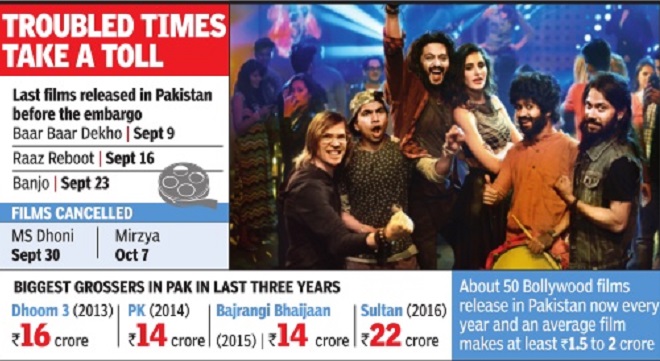Pakistan: Market for Indian cinema
This is a collection of articles archived for the excellence of their content. |
Indian films screened in Pakistan, 2013-16
Size of Pakistani market/ History of relations

This graphic gives an idea of the three years preceding the ban: Indian films screened in Pakistan, 2013-16
It is a burgeoning cross-border business that's worth more than Rs 100 crore even by conservative estimates.
Try this for size: about 50 Bollywood films now release in Pakistan every year and, on an average, each makes at least Rs 1.5 to 2 crore. The biggest grossers in Pakistan in the last three years include the Aamir Khan thriller Dhoom 3, which earned Rs 16 crore, Raju Hirani's PK, which spoke out against organised religion, Bajrangi Bhaijaan, which dealt with an Indian youth's journey into Pakistan to reunite a child with her parents, and Sultan, which muscled its way past all the others at the box-office (Rs 22 crore).
The ban on screening Indian films in Pakistan was formalised at a meeting of exhibitors and distributors in Karachi [in Oct 2016] and was in reaction to a resolution by a film producers' body in India against the use of Pakistani artistes in Indian films. Analysts say the ban in Pakistan will hurt the country's domestic market as well, which is showing signs of recovery after decades of Islamisation and strict censorship.
A four-decade embargo on Indian films (imposed after the 1965 war) was lifted in 2007. “For either to take such a decision now means they've put commercials on the back-burner after building bridges,“ says Avtar Panesar, vice-president (international operations) at Yash Raj Films in London.
“From an overseas theatrical revenue perspective, Pakistan wasn't even in single digits 10 years ago and now it's gone up to 12 per cent. In fact, for big Bollywood releases, it's often the No.3 highest-grossing territory after the US and UAE.They're a substantial market for us and only becoming bigger. In fact, Pakistan has climbed the ranks so rapidly that once their market is more mature, it should theoretically become the largest international market for Indian films,“ he said.
Pakistan's love for Hindi films continued through the years when Lollywood (derived from Lahore, its city of origin) went into decline, the total number of movie halls fell to about 30 and the industry produced not more than two releases a year. The Pakistani viewership depended on piracy to sustain its interest in Hindi films.
“For us, it was about bringing legitimacy to Hindi films being watched in Pakistan via pirated circles,“ recalls Mukesh Bhatt, who along with his brother Mahesh was part of a bilateral team of film-makers and exhibitors who initiated a dialogue to allow Indian movies into Pakistan once more.
It was during Pervez Musharraf 's regime that the iron curtain was finally lifted. Audiences returned to the theatres, new investors stepped in and deteriorating Pakistani creative content, too, saw a revival. Today , the Pakistani film industry boasts of a $30 million box office and 116 screens.
Nadeem Mandviwalla is CEO of Mandviwalla Entertainment, a film production and distribution company and owner of Atrium Cinemas, the first 3D multiplex in Karachi
Indian films have been the best-sellers in Pakistan, followed by Hollywood and then Pakistani films.
Gultasab says, “Pakistani content is not enough to sustain our theatres, that have high operational costs and need at least 40 films in a year.“